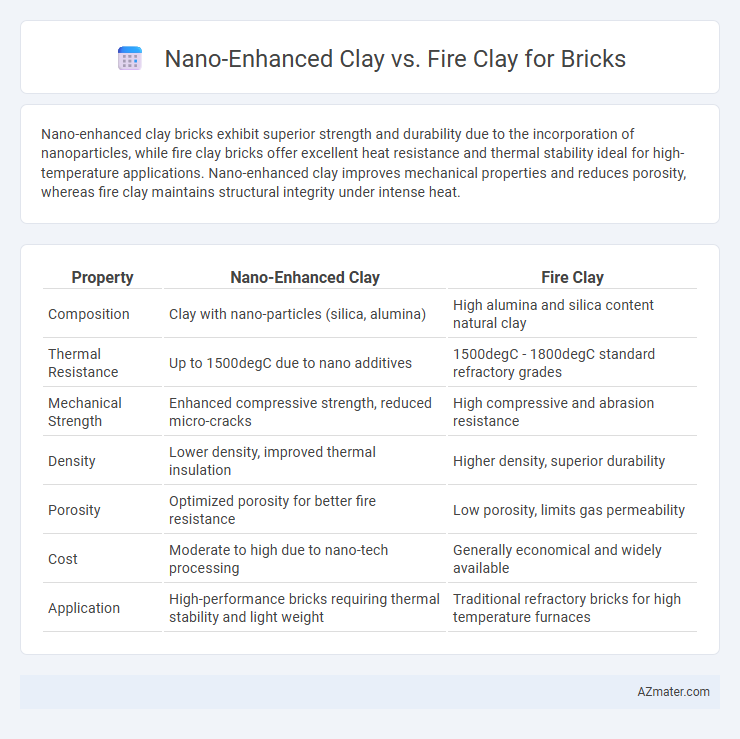Nano-enhanced clay bricks exhibit superior strength and durability due to the incorporation of nanoparticles, while fire clay bricks offer excellent heat resistance and thermal stability ideal for high-temperature applications. Nano-enhanced clay improves mechanical properties and reduces porosity, whereas fire clay maintains structural integrity under intense heat.
Table of Comparison
| Property | Nano-Enhanced Clay | Fire Clay |
|---|---|---|
| Composition | Clay with nano-particles (silica, alumina) | High alumina and silica content natural clay |
| Thermal Resistance | Up to 1500degC due to nano additives | 1500degC - 1800degC standard refractory grades |
| Mechanical Strength | Enhanced compressive strength, reduced micro-cracks | High compressive and abrasion resistance |
| Density | Lower density, improved thermal insulation | Higher density, superior durability |
| Porosity | Optimized porosity for better fire resistance | Low porosity, limits gas permeability |
| Cost | Moderate to high due to nano-tech processing | Generally economical and widely available |
| Application | High-performance bricks requiring thermal stability and light weight | Traditional refractory bricks for high temperature furnaces |
Introduction to Advanced Brick Materials
Nano-enhanced clay bricks incorporate nanoparticles that improve strength, durability, and thermal insulation compared to traditional fire clay bricks. Fire clay bricks, known for their high refractoriness and resistance to thermal shock, are commonly used in high-temperature applications but lack the advanced mechanical properties of nano-enhanced variants. The integration of nanomaterials in clay bricks revolutionizes construction by optimizing performance, energy efficiency, and longevity in modern building materials.
Understanding Fire Clay: Properties and Applications
Fire clay is a refractory material known for its high alumina content, excellent heat resistance, and thermal stability, making it ideal for manufacturing durable firebricks used in furnaces, kilns, and fireplaces. Compared to nano-enhanced clay, fire clay exhibits superior structural integrity under extreme temperatures but lacks the enhanced mechanical strength and reduced porosity offered by nanomaterial integration. Its widespread application in industrial thermal insulation and high-temperature environments underscores its importance in refractory brick production.
What is Nano-enhanced Clay?
Nano-enhanced clay is a advanced building material created by incorporating nanoparticles into traditional clay, significantly improving its mechanical strength, durability, and thermal insulation properties compared to conventional fire clay. The nanoparticles increase the clay's surface area and reactivity, resulting in enhanced microstructure and reduced porosity that contribute to better compressive strength and resistance to water absorption. This innovative technology offers superior performance for brick manufacturing, providing bricks with improved longevity and environmental resilience.
Composition Differences: Nano-enhanced vs Fire Clay
Nano-enhanced clay incorporates nanoparticles such as silica, alumina, or carbon nanotubes to improve mechanical strength, thermal resistance, and durability compared to traditional fire clay. Fire clay mainly consists of refractory alumina-silicate minerals with high plasticity and heat resistance, making it suitable for high-temperature applications but lacking enhanced structural properties. The nano additives in nano-enhanced clay modify the microstructure by reducing porosity and increasing bonding at the molecular level, resulting in bricks with superior performance under thermal and mechanical stress.
Mechanical Strength Comparison
Nano-enhanced clay bricks exhibit superior mechanical strength compared to traditional fire clay bricks due to the incorporation of nanoparticles that improve particle bonding and reduce porosity. Studies indicate that nano-enhanced clay can increase compressive strength by up to 30%, enhancing load-bearing capacity and durability. Fire clay bricks, while known for their high heat resistance and moderate strength, generally demonstrate lower mechanical strength metrics, making nano-enhanced clay a preferred choice for structural applications requiring enhanced resilience.
Thermal Insulation and Heat Resistance
Nano-enhanced clay bricks exhibit superior thermal insulation due to their reduced thermal conductivity and increased porosity at the nanoscale, which significantly limits heat transfer. Fire clay bricks, known for their high alumina content, offer exceptional heat resistance and can withstand temperatures exceeding 1500degC, making them ideal for high-temperature industrial applications. The integration of nanomaterials in clay enhances the overall energy efficiency of bricks by improving thermal stability while maintaining structural integrity under extreme heat conditions.
Water Absorption and Durability
Nano-enhanced clay bricks exhibit significantly lower water absorption rates compared to traditional fire clay bricks, improving resistance to moisture infiltration. The incorporation of nanoparticles enhances the microstructure, leading to increased density and reduced porosity, which directly contributes to superior durability and longer lifespan. Fire clay bricks, while known for heat resistance, generally have higher water absorption, making them more susceptible to weathering and structural degradation over time.
Environmental Impact and Sustainability
Nano-enhanced clay bricks demonstrate superior environmental performance by significantly reducing energy consumption during production due to lower firing temperatures compared to traditional fire clay bricks. The incorporation of nanomaterials enhances mechanical strength and durability, extending the bricks' lifespan and reducing the need for frequent replacements, which lowers overall resource extraction and waste generation. Fire clay bricks, while durable, typically require higher firing temperatures and more raw material extraction, resulting in greater carbon emissions and environmental degradation.
Cost Analysis and Production Feasibility
Nano-enhanced clay offers improved mechanical properties and durability compared to traditional fire clay, but its higher raw material and processing costs can significantly impact overall production expenses. Fire clay remains cost-effective due to its widespread availability and established manufacturing techniques, making it a preferred choice for large-scale brick production with lower investment requirement. Assessing production feasibility should consider not only material costs but also scalability factors, energy consumption, and compatibility with existing brick-making equipment.
Future Trends in Brick Manufacturing
Nano-enhanced clay offers significant improvements in brick manufacturing, including superior strength, durability, and thermal insulation compared to traditional fire clay. Advances in nanotechnology enable the incorporation of nanoparticles that enhance moisture resistance and reduce firing temperatures, leading to energy-efficient production processes. Future trends indicate widespread adoption of nano-enhanced clay bricks driven by sustainability goals and stricter environmental regulations in the construction industry.

Infographic: Nano-enhanced clay vs Fire clay for Bricks
 azmater.com
azmater.com